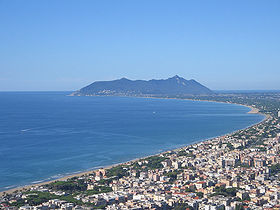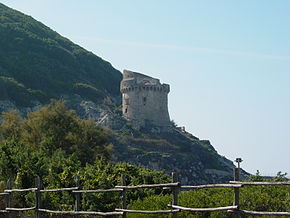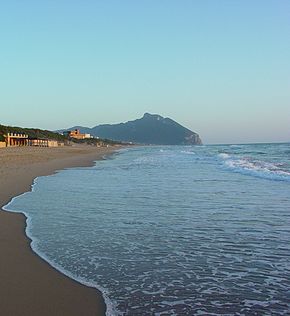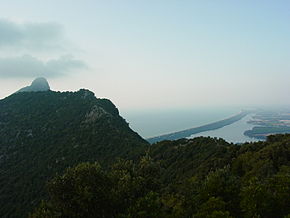- Mount Circeo
-

Mount Circeo as seen from Terracina, ItalyProminence 541 metres (1,775 ft) Location Mount Circeo Location San Felice Circeo, Lazio, Italy Coordinates 41°14′N 13°03′E / 41.2333°N 13.05°ECoordinates: 41°14′N 13°03′E / 41.2333°N 13.05°E  "Torre Paola" at Sabaudia, a 16th century watchtower built by will of Pope Pius IV at the west end of the promontory, guarding the canal.
"Torre Paola" at Sabaudia, a 16th century watchtower built by will of Pope Pius IV at the west end of the promontory, guarding the canal.
Monte Circeo or Cape Circeo (Italian: Promontorio del Circeo, Latin: Mons Circeius) is a mountain remaining as a promontory that marks the southwestern limit of the former Pontine Marshes. Although a headland, it was not formed in the same way as headlands are usually formed, by erosion of the coast, but is a remnant of the orogenic processes that created the Apennines. The entire coast of Lazio, in which the mountain and the marsh are located, was a chain of barrier islands formed on a horst, made part of the mainland by sedimentation of the intervening graben.
Monte Circeo, as it is sometimes also called in Italian, is located on the southwest coast of Italy, about 100 kilometres (62 mi) south/southeast of Rome, near San Felice Circeo, on the coast between Anzio and Terracina. At the northern end of the Gulf of Gaeta, it is about 5 kilometres (3.1 mi) long by 1.5 kilometres (0.93 mi) wide at the base, running from east to west and surrounded by the sea on all sides except the north. The land to the north of it is 15 metres (49 ft) above sea level, while the summit of the promontory is 541 metres (1,775 ft). While the headland is quite steep and hilly, the land immediately to the east of it is very low-lying and swampy. Most of the ancient swamp has been reclaimed for agriculture and urban areas. The mountain, the coastal zone as far north as Latina, including the only remaining remnant of the swamp, and two of the Pontine Islands offshore, Zannone and Ponza, have been included in the Circeo National Park.
The mountain is composed mostly of marl and sandstone from the Paleogene and of limestone from the lower Early Jurassic.
Contents
Prehistory
In 1939 the skull of a Neanderthal man was found by a team led by Alberto Carlo Blanc in the Guattari Cave; and several other findings also prove it was inhabited in prehistorical times.
Ancient Roman times
The origin of the name is uncertain: it has naturally been connected with the legend of Circe, and Victor Bérard (in Les Phéniciens et l'Odyssée, ii. 261 seq.) maintains in support of the identification that Aiaia, the Greek name for the island of Circe, is a faithful transliteration of a Semitic name, meaning "island of the hawk". The difficulty has been raised, especially by geologists, that the promontory ceased to be an island at a period considerably before the time of Homer; but Procopius remarked that the promontory has all the appearance of an island until one is actually upon it.[1]
Upon the east end of the ridge of the promontory are the remains of an enceinte, forming roughly a rectangle of about 200 by 100 meters of very fine polygonal work, on the outside, the blocks being very carefully cut and jointed and right angles being intentionally avoided. The wall stands almost entirely free, as at Arpinum—polygonal walls in Italy are as a rule embanking walls—and increases considerably in thickness as it descends. The blocks of the inner face are much less carefully worked both here and at Arpinum. It seems to have been an acropolis, and contains no traces of buildings, except for a subterranean cistern, circular, with a beehive roof of converging blocks. The modern village of San Felice Circeo seems to occupy the site of the ancient town, the citadel of which stood on the mountain top, for its medieval walls rest upon ancient walls of Cyclopean work of less careful construction than those of the citadel, and enclosing an area of 200 by 150 m (660 by 490 ft).
Circeii, as it was then known, was founded as a Roman colony at an early date— according to some authorities in the time of Tarquinius Superbus,[2] but more probably about 390 BC. The existence of a previous population, however, is very likely indicated by the revolt of Circei in the middle of the 4th century BC,[3] so that it is doubtful whether the walls described are to be attributed to the Romans or the earlier Volscian inhabitants. At the end of the republic, however, or at latest at the beginning of the imperial period, the city of Circei was no longer at the east end of the promontory, but on the east shores of the Lago di Paola (a lagoon — now a considerable fishery — separated from the sea by a line of sandhills and connected with it by a channel of Roman date: Strabo speaks of it as a small harbour) 1.5 kilometres (0.93 mi) north of the west end of the promontory. Here are the remains of a Roman town, belonging to the 1st and 2nd centuries, extending over an area of some 600 by 500 meters ((2,000 by 1,600 ft), and consisting of fine buildings along the lagoons, including a large open piscina or basin, surrounded by a double portico, while farther inland are several very large and well-preserved water-reservoirs, supplied by an aqueduct of which traces may still be seen. An inscription speaks of an amphitheatre, of which no remains are visible. The transference of the city did not, however, mean the abandonment of the east end of the promontory, on which stand the remains of several very large villas. An inscription, indeed, cut in the rock near San Felice, speaks of this part of the Latin: promonturium Veneris ("promontory of Venus"; the only case of the use of this name) as belonging to the city of Circei. On the south and north sides of the promontory there are comparatively few buildings, while, at the west end there is a sheer precipice to the sea.
The town only acquired municipal rights after the Social War, and was a place of little importance, except as a seaside resort. For its villas Cicero compares it with Antium, and probably both Tiberius and Domitian possessed residences there. Presumed Domitian's villa contained important artistic works, like the Apollo and the Faun with the transverse flute and a spa. The beetroot and oysters of Circei had a certain reputation. The view from the highest summit of the promontory (which is occupied by ruins of a platform attributed with great probability to a temple of Venus or Circe) is of remarkable beauty; the whole mountain is covered with fragrant shrubs. From any point in the Pontine Marshes or on the coast-line of Latium the Circeian promontory dominates the landscape in the most remarkable way.
Today
Mount Circeo is today included in the National Park of Circeo, instituted in 1934 on 5,616 ha (56.16 km2; 13,880 acres; 21.68 sq mi) over the territories of Latina, Sabaudia, San Felice Circeo and Zannone Island (minor island of Ponziane Archipelago).
References
 This article incorporates text from a publication now in the public domain: Chisholm, Hugh, ed (1911). Encyclopædia Britannica (11th ed.). Cambridge University Press.
This article incorporates text from a publication now in the public domain: Chisholm, Hugh, ed (1911). Encyclopædia Britannica (11th ed.). Cambridge University Press.
External links
 Mountains of the LazioMonte Abate · Monte Altino · Monte Appiolo · Maschio dell'Ariano · Maschio di Lariano · Monte Artemisio · Monte Autore · Monte Carbonaro · Monte Cavo · Monte Cefalo · Cima del Redentore (monti Aurunci) · Circeo · Monte Crispi · Monte Dragone · Monte Faggeto · Monte Fammera · Mont Fogliano · Monte Fusco · Monte Gorzano · Monte Guadagnolo · Monte Lauro in Gaeta · Monte Lauzo · Le Rave Fosche · Monte Livata · Mainarde · Maschio delle Faete · Meta (monte) · Monna · Monte Caira · Monte Cervello · Monte Revole · Monte Sorgenze · Monte Trina · Monte Val de' Varri - Monte Faito - Monte San Nicola · Monte di Cambio · Monte le Pezze · Parco regionale urbano Monte Orlando · Monte Orso · Monte Petrella · Monte Pizzuto · Monte RuazzoCategories:
Mountains of the LazioMonte Abate · Monte Altino · Monte Appiolo · Maschio dell'Ariano · Maschio di Lariano · Monte Artemisio · Monte Autore · Monte Carbonaro · Monte Cavo · Monte Cefalo · Cima del Redentore (monti Aurunci) · Circeo · Monte Crispi · Monte Dragone · Monte Faggeto · Monte Fammera · Mont Fogliano · Monte Fusco · Monte Gorzano · Monte Guadagnolo · Monte Lauro in Gaeta · Monte Lauzo · Le Rave Fosche · Monte Livata · Mainarde · Maschio delle Faete · Meta (monte) · Monna · Monte Caira · Monte Cervello · Monte Revole · Monte Sorgenze · Monte Trina · Monte Val de' Varri - Monte Faito - Monte San Nicola · Monte di Cambio · Monte le Pezze · Parco regionale urbano Monte Orlando · Monte Orso · Monte Petrella · Monte Pizzuto · Monte RuazzoCategories:- Peninsulas of Italy
- Ancient Roman geography
- Headlands of Italy
- Biosphere reserves of Italy
- Mountains of Lazio
Wikimedia Foundation. 2010.



